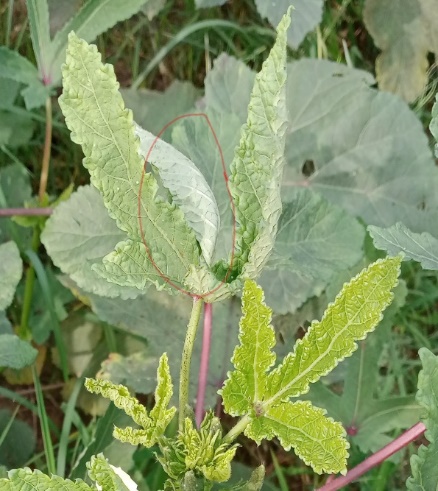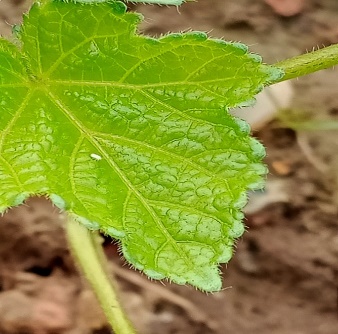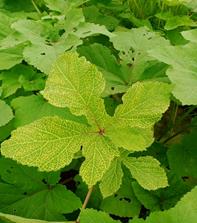भिंडी का नया उभरता हुआ वायरल रोग ओकरा एनेशन लीफ कर्ल वायरस (OELCuV) और उसका प्रबंधन
Okra or lady’s finger (Abelmoschus esculentus L. Moench) is an important vegetable grown throughout the world. In India, okra is exported to foreign countries as a fresh vegetable, constitute 70% of the total fresh vegetable earning (APEDA 2000). Okra has adequate nutritional value, it is a good source of carbohydrates, protein, dietary fibres, vitamin C, vitamin K and unsaturated fatty acids. It can improve the nutritional status of malnourished people, (Gemede, et al 2015).
It is considered as a protective supplementary food, due to its vigorous nature, dietary fibre and distinct seed protein balance of lysine and tryptophan amino acids. Okra yield is affected by biotic and abiotic factors. The foremost biotic factor is disease which reduces yield up to 100 percent.
Bhendi yellow vein mosaic virus was major disease in okra. It’s transmitted by whitefly (Bemisia tabaci). Viruses contain bipartite genome DNA-A DNA-B. The DNA-A components encoded a replication associated protein that is vital for viral DNA replication, the coat protein (CP) and transcription activator protein that controls late gene expression.
The DNA-B component encodes a movement protein (MP), both of which are crucial for systemic infection of plants. Symptoms of the disease are yellowing of veins, stunted growth, malformation and pod abnormalities.
Nowadays, Okra enation leaf curl virus (OELCuV) disease is emerging as a serious threat to okra cultivation affecting both yield & fruit quality. The genome of okra enation leaf curl virus (OELCuV) is ssDNA, it belongs to the genus begomovirus & family geminiviridae. A complex of monopartite (DNA-A) associated with beta satellite.
OELCuV is transmitted by insect vector whitefly (Bemisia tabaci Gen.) in semi-persistent manner only not through seed & sap. Whitefly exists as a number of strains or biotypes which are distinguished by host crops responses to insecticides and DNA fingerprints. Whitefly biotypes B is a serious pest in many vegetables including okra, cucurbits, chilli, tomato, brinjal, brassicas, sweet potato and beans.
The whitefly has a high reproduction rate and a short generation time (18 to 28 days). Due to favourable condition disease incidence is increasing day to day. It has the ability to quickly develop resistance to insecticides.
Symptom of Okra enation leaf curl virus:
The disease initially causes small pin-head enations on the under surfaces of leaves with a warty, rough texture, upward curled leaves. Severe leaf curling with vein thickening symptom & stunted plant growth. Affected plants show a twisting and bending of the petiole, stem and lateral branches with leaves becoming thick & leathery
Fruits from infected plants are small, deformed & unfit for marketing. Okra enation leaf curl virus (OELCuV) and yellow vein mosaic virus (YVMV) symptoms can be observed in the same plant at the same time. Epidemiology, etiology and management of both diseases are same.
 |
 |
| Vector: Whitefly | |
 |
| Symptom of OELCuV |
Favourable conditions for Okra enation leaf curl virus:
Hot weather with little or no rainfall is conducive for virus disease development and also for the multiplication of white fly. The occurrence and severity of OELCuV is season and location-specific. Temperature ranges from 32-35 oC favourable for the growth of white fly. The summer season is more conducive for OELCuV than the rainy season.
Factors responsible for the outbreak of OELCuV:
- Introduction of efficient whitefly biotype.
- Reduction in genetic diversity of the crop.
- Excess application of whitefly population.
- The tendency of Begomo viruses to evolve/ adapt by recombination & component exchange.
- Monocropping of okra as well as other hosts like chilli, tomato, brinjal, cotton around the year in the same area.
- Intensification in agriculture to feed an ever-increasing population of humans
Management of OELCuV:
Cultural method:
- There is no viricide available in the market to control viral diseases; once a plant is infected it’s difficult to manage this.
- Roughing out of infected plants at the initial stage of infection.
- Avoid planting overlapping crops of okra, its leads to outbreaks of virus.
- Proper selection of virus tolerant varieties/ hybrids can be effective.
- To reduce disease spread, plant two rows of border cropping with maize, sorghum or bajra, 7-15 days before sowing of okra.
- Crop rotation is the best way to avoid the disease.
- Destroy residual crops immediately after harvest to reduce whitefly migration.
- Rough out alternate host from the adjoining field, it serves as a reservoir of whiteflies during offseason.
- Grow resistant varieties like Pusa Bhendi 5, Prabhani Kranti, Arka Anamika, Kashi Vardaan, Kashi Shristi, Kashi Bhairav.
Physical method:
- Install yellow sticky trap @ 12 per hectare at various places in the field to reduce whitefly population.
Botanical method:
- Foliar spray of Azadiractin @ 20ml/lit of water. It acts as an antifeedant, it disrupts insect moulting, repels larva & adults and deters egg-laying.
- Spray neem oil 3% to kill adult whitefly at 15 days interval.
- Spray neem seed kernel extract (NSKE) 5% in 200 lit of water with teepol.
Chemical method:
- Seed treatment with imidacloprid 48 % FS or 70 % WS @ 7 g/kg or Thiamethoxam 70 % WS @ 2.8 g/kg of seed.
- Spray fenpropathrin 30% EC @ 3.5ml/10 lit of water or Imidacloprid 17.8 % SL 2 ml/10 lit.
- Spray pyriproxyfen 5% EC + fenpropathrin 15% EC @ 1ml/10 lit of water.
Authors
Nidhika Rani, A.P. Bhagat and R. N. Gupta
Bihar Agricultural University, Sabour, Bhagalpur-813210
Email id:
